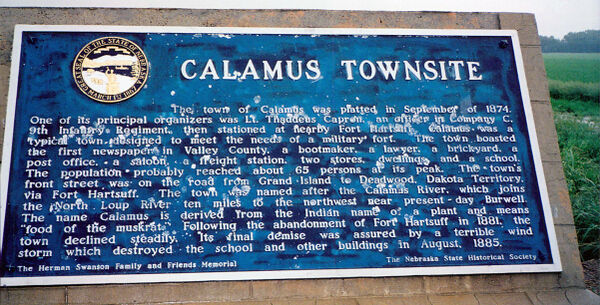Difference between revisions of "Nebraska Historical Marker: Calamus Townsite"
m |
|||
| Line 4: | Line 4: | ||
Rural Unnamed Rd, Ord, Valley County, Nebraska | Rural Unnamed Rd, Ord, Valley County, Nebraska | ||
| − | View this marker's location '''[https:// | + | View this marker's location '''[https://www.google.com/maps/place/41%C2%B042'57.7%22N+99%C2%B001'12.7%22W/@41.716039,-99.0207452,201m/data=!3m2!1e3!4b1!4m5!3m4!1s0x0:0x0!8m2!3d41.716038!4d-99.020198?hl=en 41.716038, -99.020198]''' |
View a map of all Nebraska historical markers, '''[http://www.nebraskahistory.org/publish/markers/texts/index.shtml Browse Historical Marker Map]''' | View a map of all Nebraska historical markers, '''[http://www.nebraskahistory.org/publish/markers/texts/index.shtml Browse Historical Marker Map]''' | ||
Revision as of 07:29, 4 April 2017
Location
Rural Unnamed Rd, Ord, Valley County, Nebraska
View this marker's location 41.716038, -99.020198
View a map of all Nebraska historical markers, Browse Historical Marker Map
Marker Text
The town of Calamus was platted in September of 1874. One of its principal organizers was Lt. Thaddeus Capron, an officer in Company C, 9th Infantry Regiment, then stationed at nearby Fort Hartsuff. Calamus was a typical town designed to meet the needs of a military fort. The town boasted the first newspaper in Valley County, a bootmaker, a lawyer, a brickyard, a post office, a saloon, a freight station, two stores, dwellings, and a school. The population probably reached about 65 persons at its peak. The town's front street was on the road from Grand Island to Deadwood, Dakota Territory, via Fort Hartsuff. The town was named after the Calamus River, which joins the North Loup River ten miles to the northwest near present-day Burwell. The name Calamus is derived from the Indian name of a plant and means "food of the muskrat." Following the abandonment of Fort Hartsuff in 1881, the town declined steadily. Its final demise was assured by a terrible wind storm which destroyed the school and other buildings in August, 1885.
Further Information
Bibliography
Marker program
See the Nebraska Historical Marker Program for more information.
